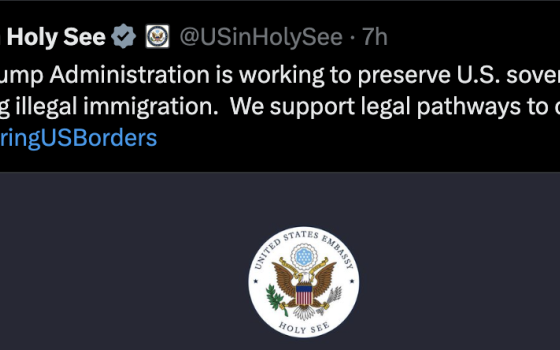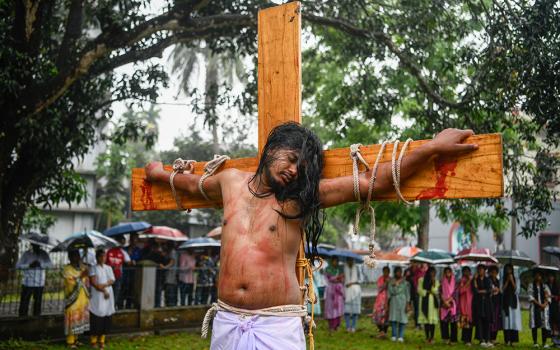A PEOPLE OF HOPE: ARCHBISHOP TIMOTHY DOLAN IN CONVERSATION WITH JOHN L. ALLEN JR.
By John L. Allen Jr.
Published by Image Books, $25
This book is a series of conversations between NCR senior correspondent John Allen and Archbishop Timothy Dolan of New York. It’s built on the premise that Dolan is a leader to watch in the arena of hierarchical politics. As Allen puts it in his introduction, Dolan has had “an eye-popping run of promotions, honors, papal votes of confidence, and signs of growing celebrity” in his rise to become the archbishop of New York. Allen believes he’s a “measure of where the church is headed.” And he obviously admires Dolan’s welcoming personality, his non-punitive style of leadership and his media savvy.
 In fact, Allen believes that Dolan is probably the best the hierarchy has to offer in contemporary America. He also admits he knows that episcopal/clerical fraternity from the inside. But it is Allen’s “insider” status that shapes both the strengths and weaknesses of this book.
In fact, Allen believes that Dolan is probably the best the hierarchy has to offer in contemporary America. He also admits he knows that episcopal/clerical fraternity from the inside. But it is Allen’s “insider” status that shapes both the strengths and weaknesses of this book.
First, the strength. Whatever one thinks of Dolan after reading this book, it is a useful contribution to American Catholicism, especially for hierarchy-watchers and New Yorkers. One learns about Dolan’s education (church history), his theological positions (very conservative), personality (gregarious, outgoing), and style (inclined toward conversation rather than confrontation).
But the weaknesses are also apparent. Catholics who yearn for church reform will surely come away from this book with a different take, asking, “Is this really the best the hierarchy can produce in the 21st century?” Do we really want to give kudos to this all-male club?
And for the life of me, I cannot figure out why Allen titled it A People of Hope. Yes, Allen says, “Dolan, at his best, incarnates the kind of upbeat, hopeful, affirming Catholicism that’s the untold story about the church today. ... Dolan is that rare senior figure who manages to put a warm human face on the church’s public image.” He paints him as the contemporary version of the old Irish pastor of the 1950s, before Vatican II. But is this the style the church needs in the 21st century when ex-Catholics -- if they were organized -- would comprise the second-largest denomination in the United States? Dolan might win back some of them, but not many, I suspect.
To many Catholics, Dolan will come across as cut from the standard hierarchical cloth, except with a smiley face. His inclination to be non-punitive is certainly preferable to the practices of some bishops in recent years, but is this a cause for celebration by “people of hope” in the 21st-century church?
This is especially evident as Allen questions Dolan about his views on hot-button church issues: the sex abuse crisis, the role of women, same-sex marriage, abortion, faith and politics, authority and dissent. On all of these, Dolan offers almost nothing new except an attempt to give a positive veneer to sexism, homophobic theology and monarchical church structures. Allen calls Dolan’s positions “affirmative orthodoxy,” but church reformers would surely say Dolan’s style simply tries to give a positive spin on positions that are major stumbling blocks for many Catholics.
On the sex abuse crisis, for example, Dolan admits that the bishops had major problems handling the issue, but says he’s still trying to figure out how a problem with “little over 4 percent of American priests” morphed into an episcopal problem. Really? Does he not know that 4 percent is a huge number for such behavior? And he can’t figure out how this became an episcopal problem? For him, the abusing priests were the central problem, not the bishops who ignored or reassigned them.
Not surprisingly, Dolan also opposes women’s ordination and same-sex marriage, and is critical of the Catholic Health Association and NETWORK for having opposed the bishops to support Obama’s health care reform. He strenuously defends the teaching role of the bishops and thinks that abortion trumps all other issues in the political domain. Even on priestly celibacy, which is a matter of discipline and not dogma, he is reluctant to consider change, although he says he might be open to dialogue.
Now, it is useful to know where Dolan stands on all these issues, but this is not -- for me at least -- a picture of hope for a “people of hope.” If anything, it’s discouraging.
Moreover, there are many topics missing in this book, and they are those where the bishops could be real sources of hope. We never find out, for example, what Dolan thinks about economic justice, the income gap in American society, poverty across the globe and what it demands of us, the role of labor unions, the wars in Iraq and Afghanistan, or interfaith collaboration and dialogue.
Finally, I wondered whether John Allen is hoping to “score twice” with another book about a possible future pope. A few years ago, he wrote a biography of Cardinal Joseph Ratzinger before he became Pope Benedict XVI. It’s not that Allen thinks that Dolan might become pope, but if the doors of the Vatican ever opened to an American, Dolan might be the one. And this book would certainly take on new significance. But, based on this book, I doubt that such an event would be a cause for hope.
[Maureen Fiedler is the host of “Interfaith Voices” on public radio, the editor of Breaking Through the Stained Glass Ceiling: Women Religious Leaders in Their Own Words, and a regular blogger for NCR.]


